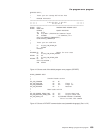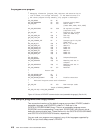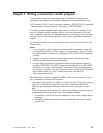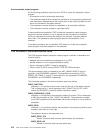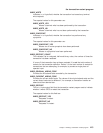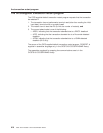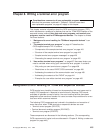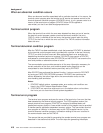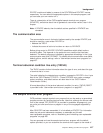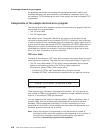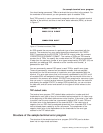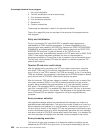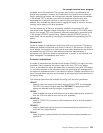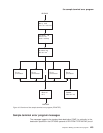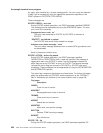
DFHTEP module and tables by means of the DFHTEPM and DFHTEPT macros,
respectively. You can select the appropriate options in this sample program, and
you can base your own version on it.
There is a description of the CICS-supplied sample terminal error program
(DFHXTEP), and advice about how to generate a user-written version, later in this
chapter.
Note: If DFHTEP abends, then the default actions specified in DFHTACP are
reinstated.
The communication area
The communication area is the basic interface used by the sample DFHTEP, and
should be used by a user-written DFHTEP to:
v Address the TACLE
v Indicate the course of action to be taken on return to DFHTACP.
Before giving control to DFHTEP, DFHTACP establishes which default actions
should be taken. This depends on the particular error condition that has been
detected. The default actions are indicated by appropriate bit settings in the 1-byte
communication area field TEPCAACT. For details about communication area fields,
default actions, and bit settings, refer to “User-written terminal error programs” on
page 437.
Terminal abnormal condition line entry (TACLE)
The TACLE contains further information about the type of error, and about the type
of terminal that is in error.
The code indicating the detected error condition is passed to DFHTEP in the 1-byte
field of the TACLE labeled TCTLEPFL. (These DFHTACP error codes, message
codes, conditions, and default actions are also listed in the
CICS Problem
Determination Guide
.)
A format description of the terminal abnormal condition line entry (TACLE) DSECT
is provided under “User-written terminal error programs” on page 437.
The sample terminal error program
CICS provides a sample terminal error program that can be used as a generalized
program structure for handling terminal errors. Note that, although the source code
form of the sample TEP (DFHXTEP) is provided in assembler language only, you
can write your own terminal error program in any of the languages supported by
CICS.
After DFHXTEP has been assembled, it is link-edited as DFHTEP. For information
about the job control statements necessary to assemble and link-edit
user-replaceable programs, refer to “Assembling and link-editing user-replaceable
programs” on page 402.
You can generate and use the sample terminal error program with the default
options provided, or you can customize the terminal error support to the needs of
background
Chapter 8. Writing a terminal error program 417



